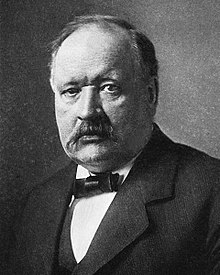Svante Arrhenius
| Svante Arrhenius | |
|---|---|
 |
|
| Born | Svante August Arrhenius 19 February 1859 Wik Castle, Sweden |
| Died | 2 October 1927 (aged 68) , Sweden |
| Nationality | Swedish |
| Fields | |
| Institutions | Royal Institute of Technology |
| Alma mater | |
| Doctoral advisor | |
| Doctoral students | Oskar Benjamin Klein |
| Known for | |
| Notable awards |
|
Svante August Arrhenius (19 February 1859 – 2 October 1927) was a Nobel-Prize winning Swedish scientist, originally a physicist, but often referred to as a chemist, and one of the founders of the science of physical chemistry. He received the Nobel Prize for Chemistry in 1903, becoming the first Swedish Nobel laureate, and in 1905 became director of the Nobel Institute where he remained until his death. His lasting contributions to science are exemplified and memorialized by the Arrhenius equation, Arrhenius definition of an acid, lunar crater Arrhenius, the mountain of Arrheniusfjellet and the Arrhenius Labs at , all named after him. He was the first to use basic principles of physical chemistry to calculate estimates of the extent to which increases in atmospheric carbon dioxide increase Earth's surface temperature through the greenhouse effect, leading him to conclude that human-caused carbon dioxide emissions are large enough to cause global warming.
Arrhenius was born on 19 February 1859 at Vik (also spelled Wik or Wijk), near Uppsala, Sweden, the son of Svante Gustav and Carolina Thunberg Arrhenius. His father had been a land surveyor for Uppsala University, moving up to a supervisory position. At the age of three, Arrhenius taught himself to read without the encouragement of his parents, and by watching his father's addition of numbers in his account books, became an arithmetical prodigy. In later life, Arrhenius enjoyed using masses of data to discover mathematical relationships and laws.
...
Wikipedia
